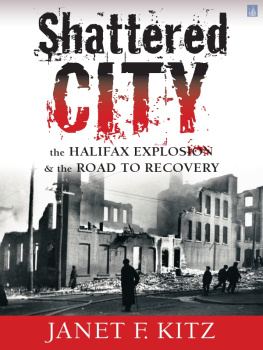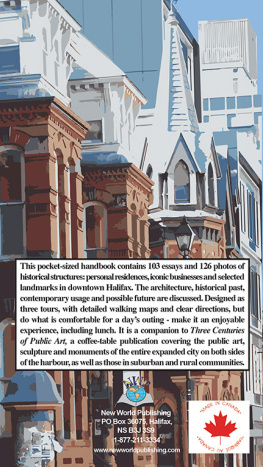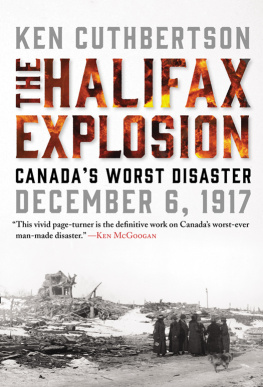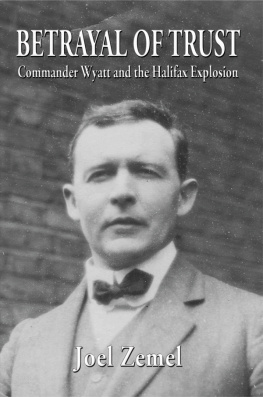Shattered
CITY
theHALIFAX EXPLOSION
& theROAD TO RECOVERY
JANET F. KITZ

Copyright Janet Kitz, 1989, 2008
E-book 2010
All rights reserved. No part of this book may be reproduced, stored in a retrieval system or transmitted in any form or by any means without the prior written permission from the publisher, or, in the case of photocopying or other reprographic copying, permission from Access Copyright, 1 Yonge Street, Suite 1900, Toronto, Ontario M5E 1E5.
Nimbus Publishing Limited
PO Box 9166, Halifax, NS B3K 5M8
(902) 455-4286
www.nimbus.ca
Printed and bound in Canada
Cover Design: Heather Bryan
Interior Design: Steven Slipp, GDA, Halifax
Previously published under ISBN 0-921054-30-0
Library and Archives Canada Cataloguing in Publication
Kitz, Janet F., 1930
Shattered city : the Halifax explosion and the road
to recovery / Janet F. Kitz. 3rd ed.
ISBN 978-1-55109-670-4
E-book ISBN 978-1-55109-820-3
1. Halifax Explosion, Halifax, N.S., 1917. I. Title.
FC2346.4.K58 2008 971.622503 C2008-902494-X

We acknowledge the financial support of the Government of Canada through the Book Publishing Industry Development Program (BPIDP) and the Canada Council, and of the Province of Nova Scotia through the Department of Tourism, Culture and Heritage for our publishing activities.
To the survivors, to those who suffered loss and deprivation,
and to those who dropped everything to rush to their aid.
To my husband, Leonard, for his understanding.
CONTENTS
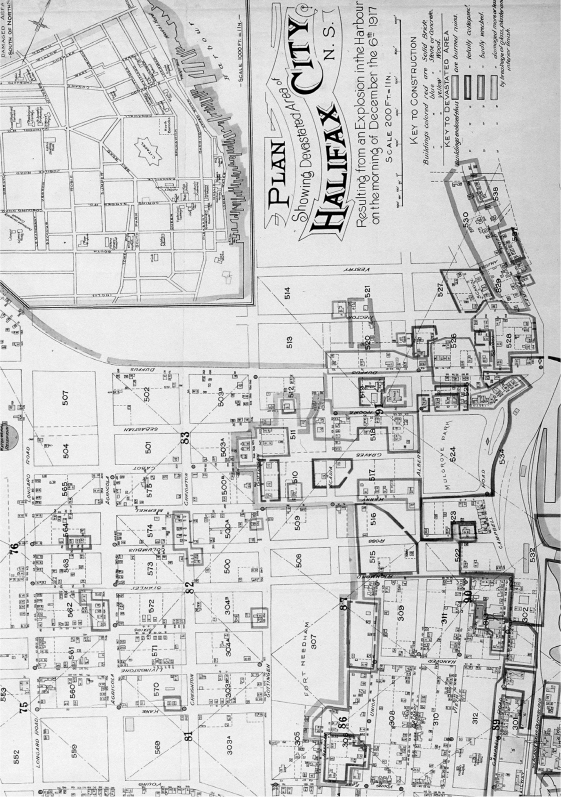
M Y INTEREST in the Halifax Explosion began in 1980, sparked by research for an anthropology paper at Saint Marys University. I started interviewing survivors, collecting materials, spending long hours at the Public Archives of Nova Scotia (PANS), and poring over old newspapers. My husbands sister and mother were among the first survivors I spoke with. Their home on Brunswick Street was wrecked during the explosion, and they had to leave the city and live in the country for some time before their house was repaired and fit to live in. Harry Kitz, the father, stayed behind and did emergency relief work for several days. Family friends also told me how the explosion had touched their lives, even though they had not been in the most seriously affected area. David Macnab, for example, might have grown up without a mother. The morning of December 6, 1917, his mother and uncle went to North Street Station to meet his father, due to arrive from Sydney. The train was delayed, so Mrs Macnab and her brother went into the concrete telephone booth to call home to see whether David, an infant, was all right. Then the Mont Blanc blew up. The station was badly damaged, and many people were killed. But the thick concrete saved the lives of Davids uncle and mother.
On November 27, 1981, Marie Elwood, curator of history at the Nova Scotia Museum, invited me to examine some boxes of cloth bags containing unclaimed effects from the Chebucto Road mortuary. There were three large boxes of jumbled bags and loose objects that had been lying in the basement of Province House since 1918. In minutes we were grimy from sixty-four-year-old soot and dust, but we were convinced that something had to be done with the bags. It had been assumed that these were possessions of unidentified victims of the explosion, but that was not the case. There were names and even some documents. I said I would try to catalogue them. The materials were consigned to the Nova Scotia Museum, and I went home with the boxes, not really knowing what was in store.
The task became completely absorbing. To begin with, I tried to use the museum system of cataloguing, which concentrates on the individual artefact. As I began to make connections between possessions and people, however, I found my interest in the human side increasing. Most bags had labels with numbers and information on them. Some labels were broken or torn, the numbers faded; sometimes the effects were listed. If victims had been positively identified, their name and, in some cases, their address had been written down. I checked the numbers on the labels without names against those on the descriptions of the unidentified dead and found that they and the effects in the bags corresponded. One label, for example, said, 138. Unidentified. Female, about 30. The description on the list read, Long dark hair. Medium light complexion. Good teeth. Plaid coat. White blouse. Light underwear. Black stockings. On third finger of right hand one 10K gold set ring with sides chased. Six stones of which three are missing, the remaining are red. Pince nez glasses. One patriotic brooch (British and French flags with maple leaf on shield in centre) and seven morning car tickets. The effects in the bag matched the description exactly.
Some of the objects in the bags were of interest for their own sake, but I was beginning to find out more about the people connected with the bags: where they had lived, their appearance, their age, and how many other members of the family were listed among the identified dead. Instead of making a catalogue of the objects and their functions, which I had intended, I ended up making a catalogue of the people who had owned the effects.
The reports, lists, and descriptions of the mortuary committee, part of the relief structure, then occupied my time. The more I learned, the greater my admiration grew for the meticulous work done by this committee under incredibly trying conditions. After going through the bags, I had a list of names with no numbers and one of numbers with no names. With these in front of me, I scanned the manuscripts or microfilm containing mortuary reports at PANS. Other details gradually emerged: the place of work, where the body had been found, who had identified it, and the date of burial. As I recognized a name that was repeated over and over again in different places on the numerical lists, I realized why no one had come forward to claim the effects.
Another problem concerned the addresses. On a label it might state, for example, Julia Carroll, 192 Campbell Road. The possessions of Julia Carroll, including letters with her name on them, were in the bag of a child whose address was given as Flynns Block. The address, 1410 Barrington Street, appeared on a bill with Julia Carrolls name on it. Using the 1917 Halifax City Directory, I discovered that all three addresses referred to the same place. In 1917 Campbell Road had become part of Barrington Street, and the numbering had changed. It takes time to become used to a new system, and most people still used the old name. The directory also told me who had lived at the different numbers. The variously written Flynn Block or Flinn Block or Building became one of my categories. So many of its residents were victims of the explosion, the survivors as well as the dead.
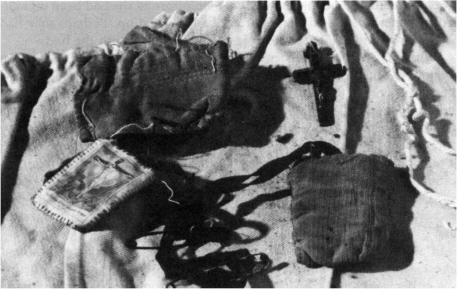
Hans Hermanson was No. 603. A crew member aboard the Norwegian Hovland, he wore these scapulars and this crucifix. (MARITIME MUSEUM)
After I had the address puzzle straightened away, I tried to find out what had happened to the various placesthe stores, industries, docks, railway yards, shipswhere people had worked. One set of effects, scapulars and a crucifix, had belonged to a young Norwegian sailor from the
Next page
